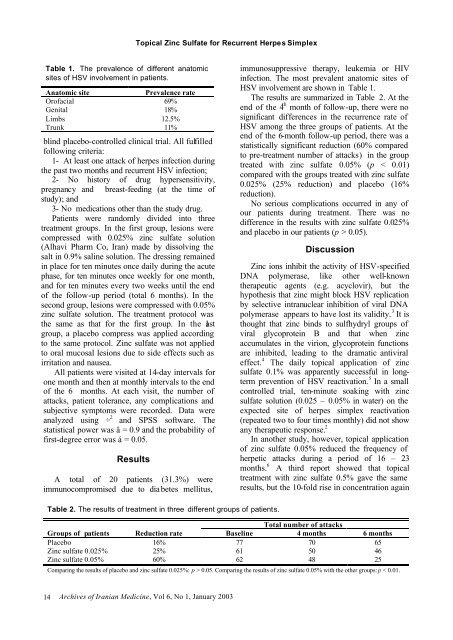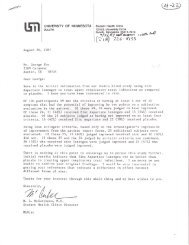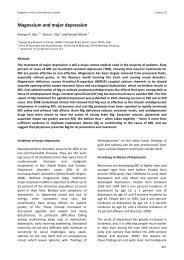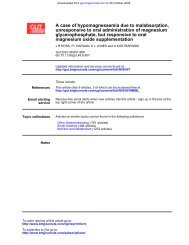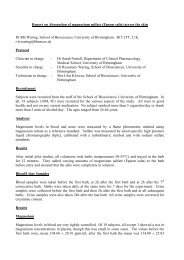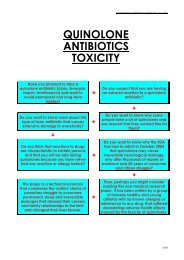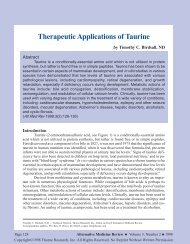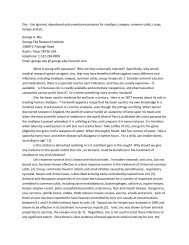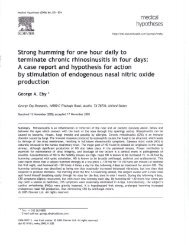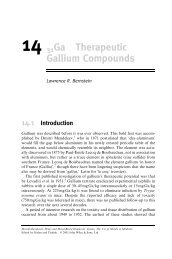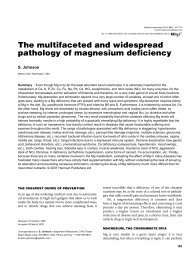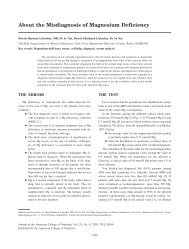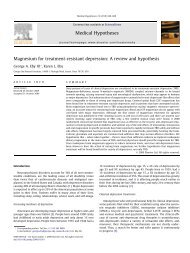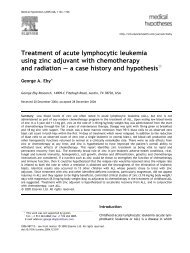2003 article - George Eby Research Institute
2003 article - George Eby Research Institute
2003 article - George Eby Research Institute
You also want an ePaper? Increase the reach of your titles
YUMPU automatically turns print PDFs into web optimized ePapers that Google loves.
Topical Zinc Sulfate for Recurrent Herpes Simplex<br />
Table 1. The prevalence of different anatomic<br />
sites of HSV involvement in patients.<br />
Anatomic site<br />
Prevalence rate<br />
Orofacial 69%<br />
Genital 18%<br />
Limbs 12.5%<br />
Trunk 11%<br />
blind placebo-controlled clinical trial. All fulfilled<br />
following criteria:<br />
1- At least one attack of herpes infection during<br />
the past two months and recurrent HSV infection;<br />
2- No history of drug hypersensitivity,<br />
pregnancy and breast-feeding (at the time of<br />
study); and<br />
3- No medications other than the study drug.<br />
Patients were randomly divided into three<br />
treatment groups. In the first group, lesions were<br />
compressed with 0.025% zinc sulfate solution<br />
(Alhavi Pharm Co, Iran) made by dissolving the<br />
salt in 0.9% saline solution. The dressing remained<br />
in place for ten minutes once daily during the acute<br />
phase, for ten minutes once weekly for one month,<br />
and for ten minutes every two weeks until the end<br />
of the follow-up period (total 6 months). In the<br />
second group, lesions were compressed with 0.05%<br />
zinc sulfate solution. The treatment protocol was<br />
the same as that for the first group. In the last<br />
group, a placebo compress was applied according<br />
to the same protocol. Zinc sulfate was not applied<br />
to oral mucosal lesions due to side effects such as<br />
irritation and nausea.<br />
All patients were visited at 14-day intervals for<br />
one month and then at monthly intervals to the end<br />
of the 6 months. At each visit, the number of<br />
attacks, patient tolerance, any complications and<br />
subjective symptoms were recorded. Data were<br />
analyzed using ÷ 2 and SPSS software. The<br />
statistical power was â = 0.9 and the probability of<br />
first-degree error was á = 0.05.<br />
Results<br />
A total of 20 patients (31.3%) were<br />
immunocompromised due to diabetes mellitus,<br />
immunosuppressive therapy, leukemia or HIV<br />
infection. The most prevalent anatomic sites of<br />
HSV involvement are shown in Table 1.<br />
The results are summarized in Table 2. At the<br />
end of the 4 th month of follow-up, there were no<br />
significant differences in the recurrence rate of<br />
HSV among the three groups of patients. At the<br />
end of the 6-month follow-up period, there was a<br />
statistically significant reduction (60% compared<br />
to pre-treatment number of attacks) in the group<br />
treated with zinc sulfate 0.05% (p < 0.01)<br />
compared with the groups treated with zinc sulfate<br />
0.025% (25% reduction) and placebo (16%<br />
reduction).<br />
No serious complications occurred in any of<br />
our patients during treatment. There was no<br />
difference in the results with zinc sulfate 0.025%<br />
and placebo in our patients (p > 0.05).<br />
Discussion<br />
Zinc ions inhibit the activity of HSV-specified<br />
DNA polymerase, like other well-known<br />
therapeutic agents (e.g. acyclovir), but the<br />
hypothesis that zinc might block HSV replication<br />
by selective intranuclear inhibition of viral DNA<br />
polymerase appears to have lost its validity. 3 It is<br />
thought that zinc binds to sulfhydryl groups of<br />
viral glycoprotein B and that when zinc<br />
accumulates in the virion, glycoprotein functions<br />
are inhibited, leading to the dramatic antiviral<br />
effect. 4 The daily topical application of zinc<br />
sulfate 0.1% was apparently successful in longterm<br />
prevention of HSV reactivation. 5 In a small<br />
controlled trial, ten-minute soaking with zinc<br />
sulfate solution (0.025 – 0.05% in water) on the<br />
expected site of herpes simplex reactivation<br />
(repeated two to four times monthly) did not show<br />
any therapeutic response. 2<br />
In another study, however, topical application<br />
of zinc sulfate 0.05% reduced the frequency of<br />
herpetic attacks during a period of 16 – 23<br />
months. 6 A third report showed that topical<br />
treatment with zinc sulfate 0.5% gave the same<br />
results, but the 10-fold rise in concentration again<br />
Table 2. The results of treatment in three different groups of patients.<br />
Total number of attacks<br />
Groups of patients Reduction rate Baseline 4 months 6 months<br />
Placebo 16% 77 70 65<br />
Zinc sulfate 0.025% 25% 61 50 46<br />
Zinc sulfate 0.05% 60% 62 48 25<br />
Comparing the results of placebo and zinc sulfate 0.025%: p > 0.05. Comparing the results of zinc sulfate 0.05% with the other groups: p < 0.01.<br />
14<br />
Archives of Iranian Medicine, Vol 6, No 1, January <strong>2003</strong>


